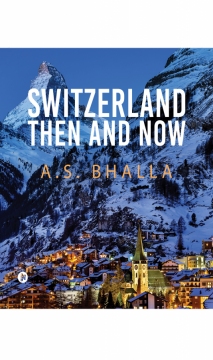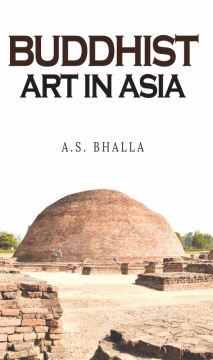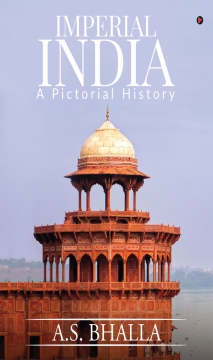
- Discover books
- For Writers
-
For Writers
-
Indie Author Championship
-
Challenges
Writing Contests
- Get Started

"It was a wonderful experience interacting with you and appreciate the way you have planned and executed the whole publication process within the agreed timelines.”
Subrat SaurabhAuthor of Kuch Woh Pal -
-
-
IN
- India
- Singapore
- Malaysia
- UAE
- 0
A.S. Bhalla
A.S. Bhalla (MA Cantab; Ph.D. Manchester) is a former Fellow of Sidney Sussex College, Cambridge, UK and former Special Adviser to the President of International Development Research Centre (IDRC), Ottawa, Canada. Dr Bhalla has held academic positions at Cambridge, Oxford, Yale and Manchester. His other historical books are Royal Tombs of India (Mapin, 2009), Buddhist Art in Asia (Austin Macauley, 2014); Glimpses of Medieval Switzerland (Austin Macauley, 2015); and Monuments, Power and Poverty in India: From Ashoka to the Raj (I.B. Tauris, 2015: first South Asian Paperback Edition, 2016). He hRead More...
A.S. Bhalla (MA Cantab; Ph.D. Manchester) is a former Fellow of Sidney Sussex College, Cambridge, UK and former Special Adviser to the President of International Development Research Centre (IDRC), Ottawa, Canada. Dr Bhalla has held academic positions at Cambridge, Oxford, Yale and Manchester. His other historical books are Royal Tombs of India (Mapin, 2009), Buddhist Art in Asia (Austin Macauley, 2014); Glimpses of Medieval Switzerland (Austin Macauley, 2015); and Monuments, Power and Poverty in India: From Ashoka to the Raj (I.B. Tauris, 2015: first South Asian Paperback Edition, 2016). He has written extensively on various other subjects. He is the (co) author of Poverty and Exclusion of Minorities in China and India (PalgraveMacmillan, 2013, 2017) Poverty among Immigrant Children in Europe (PalgraveMacmillan, 2009); Poverty and Exclusion in a Global World (PalgraveMacmillan, 1999, 2004); Globalization, Growth and Marginlaization (Macmillan, 1998); Facing the Technological Challenge (Macmillan, 1996) and Uneven Development in the Third World (Macmillan,1992, 1995) among other publications.
Read Less...Crop your profile image

Switzerland Then and Now
Books by A.S. Bhalla
The book is a sequel to author’s earlier book on Switzerland, Glimpses of Medieval Switzerland. It breaks new ground by examining how medieval Switzerland has changed into today’s tolerant country in accepting tourists from different cultures despite growing anti-immigrant attitudes, welcoming Indian mystics as well as film producers and directors (even honouring them!) and adopting such practices as Indian Ayurvedic treatments and promoting Japan
The book is a sequel to author’s earlier book on Switzerland, Glimpses of Medieval Switzerland. It breaks new ground by examining how medieval Switzerland has changed into today’s tolerant country in accepting tourists from different cultures despite growing anti-immigrant attitudes, welcoming Indian mystics as well as film producers and directors (even honouring them!) and adopting such practices as Indian Ayurvedic treatments and promoting Japanese tea ceremonies. The book focuses on the growth of Asian tourism, which is discussed by destination, to such places/regions as Bernese Highlands including Interlaken, Lucerne and Zurich. Special attention is paid to the role of Indian Bollywood movies shot in Switzerland in the rise of Indian tourists in the country. Also discussed are celebrities (kings and queens, writers and film stars) who visited Switzerland for holidays (Queen Victoria, for example) or for work. Illustrations are based on over 100-year old vintage postcards in the author’s private collection.
Buddhist Art in Asia
Books by A.S. Bhalla
Buddhism, which originated in India in the sixth century BC, faded into oblivion by the thirteenth century. However, it spread to other countries in Asia, and along with it, Buddhist art. The book investigates how representations of Buddhism and Buddhist art evolved between regions and between epochs. From India to Thailand and Burma (Myanmar) and eventually to China, the religion grew in influence only to die and thrive again in different forms. With it grew d
Buddhism, which originated in India in the sixth century BC, faded into oblivion by the thirteenth century. However, it spread to other countries in Asia, and along with it, Buddhist art. The book investigates how representations of Buddhism and Buddhist art evolved between regions and between epochs. From India to Thailand and Burma (Myanmar) and eventually to China, the religion grew in influence only to die and thrive again in different forms. With it grew different forms of Buddhist art (architecture, sculpture and painting) from Afghanistan, India, Nepal and Sri Lanka in South Asia to Cambodia, Indonesia and Thailand in Southeast Asia and China, Japan and South Korea in East Asia. A number of issues such as the survival of Buddhism despite onslaughts of Islam and Hinduism, royal patronage of Buddhist art and the role of monks (normally mendicants surviving on alms) in building impressive monasteries and cave temples are discussed in the shadows of Buddhist architecture, murals and sculpture. The book contains rich illustrations of temples, monasteries and stupas as well as paintings and sculptures from a number of holy Buddhist sites including Ajanta, Amaravati, Bharhut, Bodhgaya, Ellora, Karle, Sanchi and Sarnath in India, Sirigiya in Sri Lanka, Angkor Wat, Angkor Thom and Banteay Srei in Cambodia, Ayutthaya and Bangkok in Thailand, Dali in China and Kamakura and Nikko Toshugo in Japan.
Imperial India
Books by A.S. Bhalla
Magnificent palaces, forts and fortresses, victory towers and memorials among others are the living symbols of imperial lavishness in India. The book describes and illustrates royal edifices from Agra, Bombay, Calcutta, Delhi, Fatehpur Sikri, Hydrebad, Lahore, Madras, Poona, Rawalpindi, Quetta and Simla. The physical history of the above architecture is juxtaposed with social history of the time; for example, segregation of the British rulers from their subjec
Magnificent palaces, forts and fortresses, victory towers and memorials among others are the living symbols of imperial lavishness in India. The book describes and illustrates royal edifices from Agra, Bombay, Calcutta, Delhi, Fatehpur Sikri, Hydrebad, Lahore, Madras, Poona, Rawalpindi, Quetta and Simla. The physical history of the above architecture is juxtaposed with social history of the time; for example, segregation of the British rulers from their subjects, and habits and customs of the colonial rulers and Indian and Burmese princes. The cultural history of the times is captured by the establishment of Shakespearean theatre, musical comedies and drama in the Indian sub-continent. Transport history is addressed through a discussion and illustration of Indian railways, among the largest transport networks in the world. My private and rare collection of vintage postcards published in Germany and the UK between 1905 and 1910 is the main source of illustrations in the book.

Are you sure you want to close this?
You might lose all unsaved changes.
Select from one of our global stores to continue
 India
India
 Malaysia
Malaysia
 Singapore
Singapore
 UAE
UAE
Warning Message
The items in your Cart will be deleted, click ok to proceed.













